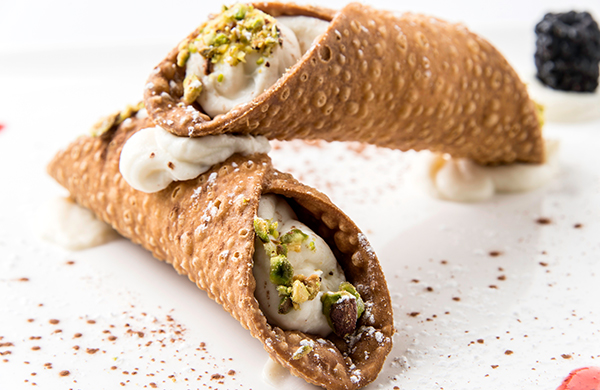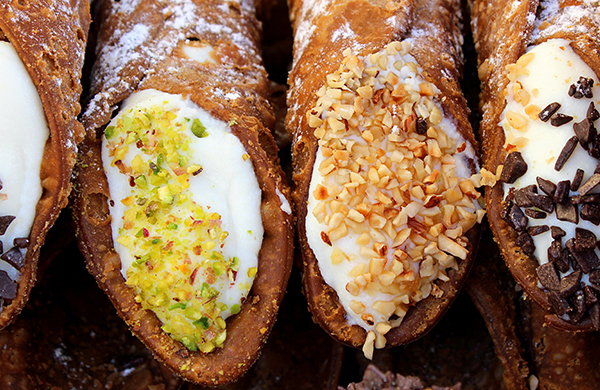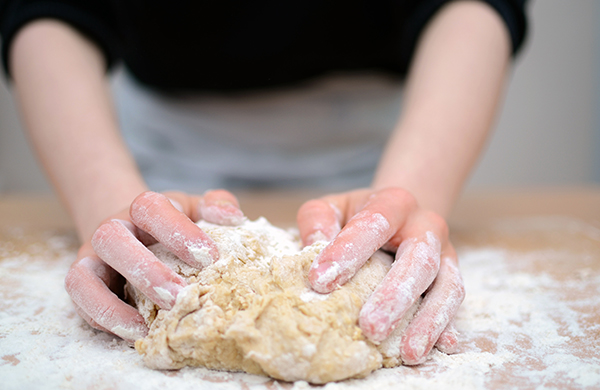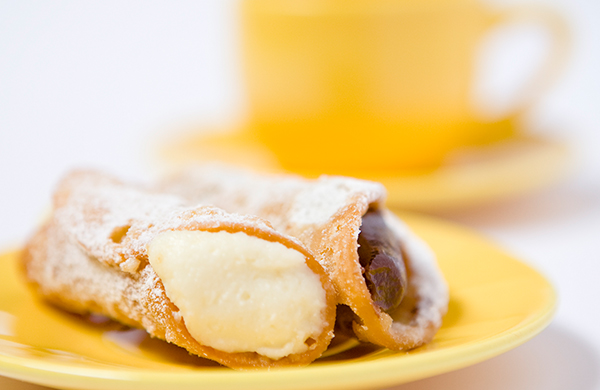
Some folks remember their first kiss in vivid detail, but I have a clearer memory of the first time I met my one true love: cannoli. I was seven or eight, and my family attended the annual Taste of Melrose Festival in Melrose Park, IL, a town with a large Italian-American population. There, somewhere between the Elvis impersonator and the fireworks finale, a dessert obsession was born.
Now, if you aren't Italian by heritage, or if you didn't grow up with an authentic Italian restaurant or bakery nearby, you might be wondering: what's in a cannoli, anyway? The next question, naturally, is "where can I find cannolis near me?" We answer those questions below, and add a little cannoli trivia for good measure.
What's in a cannoli?
No matter what version of cannoli you get, it must be a tube-shaped shell of fried dough, brimming with a sweet, creamy filling of ricotta cheese.
But there is plenty of variety after that. Depending on the recipe, the cannoli filling might also contain chocolate chips or bits of candied fruit. The ends are typically dipped in crushed pistachios, but it's also common to find cannolis garnished with more chocolate chips, sliced almonds, or just a simple dusting of powdered sugar.
Where can I find cannolis near me?
Now you know what a cannoli is, the obvious next step is to try it. Which begs the question of where to buy cannolis near you.
To find deals for cannolis near you, click one of these deals. Each of these establishes
 New York: 42% Off at Da Francesco in Brooklyn
New York: 42% Off at Da Francesco in Brooklyn
 Los Angeles: 40% Off at The Sit Down in Hollywood
Los Angeles: 40% Off at The Sit Down in Hollywood
 Chicago: 44% Off at Gulliver's Pizza in West Rogers Park
Chicago: 44% Off at Gulliver's Pizza in West Rogers Park
 Dallas: 43% Off at La Bistro Italian Restaurant in Hurst, TX
Dallas: 43% Off at La Bistro Italian Restaurant in Hurst, TX
 Philadelphia: 5% Cash Back at Valley Forge Trattoria and Lounge
Philadelphia: 5% Cash Back at Valley Forge Trattoria and Lounge
 Houston: 30% Off at Two Guys Pizzeria
Houston: 30% Off at Two Guys Pizzeria
 Miami: 45% Off at Manhattan Chicago Pizza
Miami: 45% Off at Manhattan Chicago Pizza
 Atlanta: 20% Cash Back at Siracusa's Pizzeria in Smyrna
Atlanta: 20% Cash Back at Siracusa's Pizzeria in Smyrna
 Washington, DC: 52% Off at Bella Napoli Italian Restaurant in Alexandria
Washington, DC: 52% Off at Bella Napoli Italian Restaurant in Alexandria
 Boston: 40% Off at Dolce Dolce Bakery in Medway
Boston: 40% Off at Dolce Dolce Bakery in Medway
Five suprising facts about cannoli...

1. You can't eat one cannoli...Literally
No, not in a "they're too good to eat just one" kinda way (although this is true). Rather, it's because the word "cannoli" is plural. Grammatically speaking, one cannoli is called a cannolo. Meaning, of course, that any time I've asked for a cannoli and was given only one treat, I was being cheated.
In all seriousness, no one is going to correct you if you mistakenly use the word cannoli to describe one cannolo. But it's a nice bit of trivia to bring out at parties thrown by grammar-savvy pastry enthusiasts.
2. The secret ingredient is a splash of wine.
I've only attempted to make homemade cannoli once in my life, and even then I used pre-made shells and focused solely on making my own filling. So I was surprised to discover that most cannoli recipes call for a splash of wine (typically marsala) in the dough.
Most sources seem to suggest that this is for flavor, but I have a hunch that cannoli bakers like wine for the same reason many pie bakers like to use vodka or vinegar in their crust. Specifically, it makes the dough pliable enough to roll easily, thereby preventing gluten formation. It also evaporates when cooking, yielding a crispy, flaky shell.

3. They're kinda the Italian cousin to paczki.
Today you can find cannoli year-round, but once they were a delicacy enjoyed only during Carnival, the indulgent period leading up to lent. With an ingredient list that includes lard, cheese, sugar, chocolate, and wine, it's basically the perfect thing to fatten yourself up with before the fasting season begins.
4. Thinner is better.
As far as dough thickness is concerned, that is. According to Best of Sicily magazine, a very thin shell is the hallmark of a good cannoli. Thicker shells, they argue, are easier to roll and fry, and only a true cannoli master takes the time to roll out a thinner, more delicate shell. This, of course, if difficult to do by hand—if you find a bakery that runs its cannoli dough through a pasta maker, you're likely in the right place.
The folks at Best of Sicily also warn to be wary of bakeries that coat the inside of their cannoli shells with chocolate. That's because the chocolate is likely there not for flavor, but to form a barrier between filling and shell, suggesting that the cannolis are pre-filled hours, or even days, ahead of time.

5. The shape is more sweet than scandalous.
Because of the cannoli's association with Carnival and spring rituals, many cannoli scholars (Cannoli historians? Cannoli academics?) have suggested that the pastry's tube-like shape is meant to suggest a certain… ahem, sensitive part of the human anatomy. However, it seems more likely that cannoli borrow their shape from their namesake: sugarcane. Indeed, the Oxford Companion to Sugar and Sweets notes that the word "cannoli" is derived from canna, the cylindrical cane reeds that were used as the first cannoli-shell molds.
Of course, if you want to read into it further, you could also consider the fact that Best of Sicily refers to mini cannoli as sigaretta, or cigarettes—which could cast further Freudian speculation onto their full-sized (read: cigar-sized) counterparts. But I'd recommend doing less thinking and more eating.

















